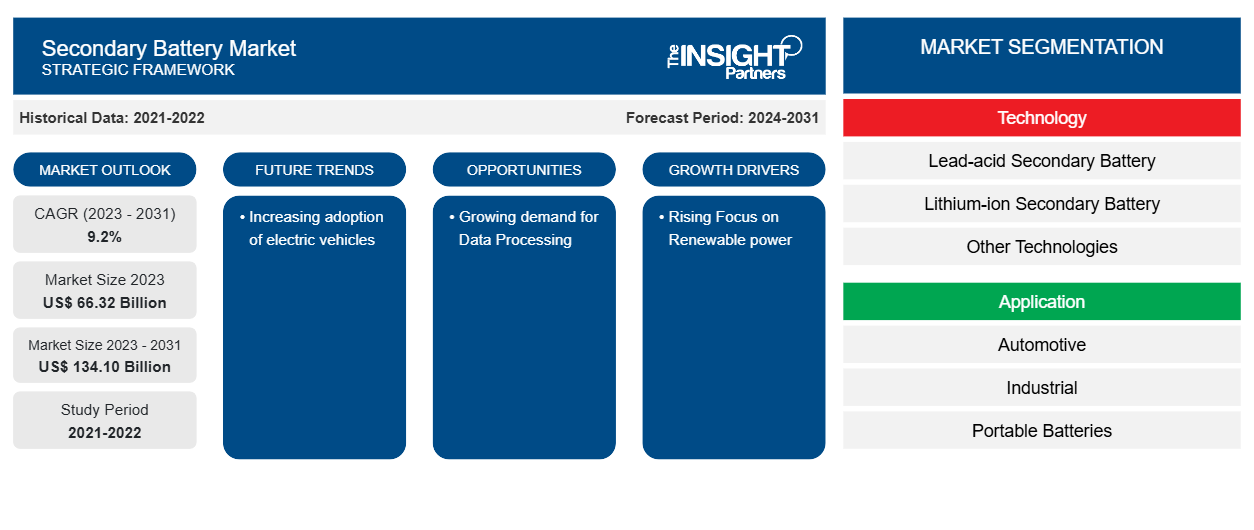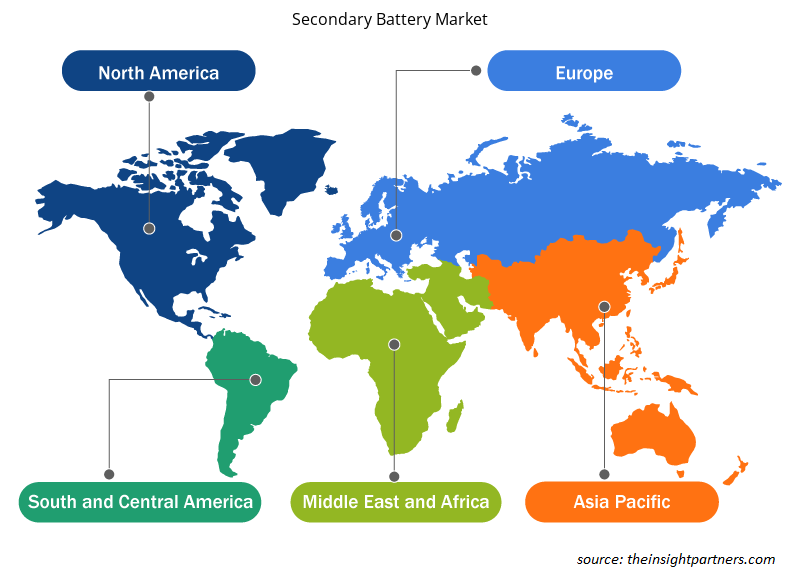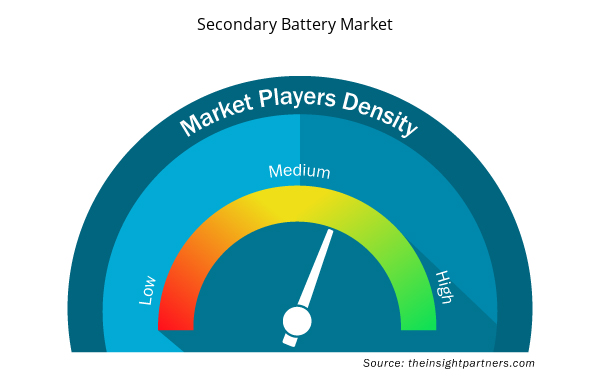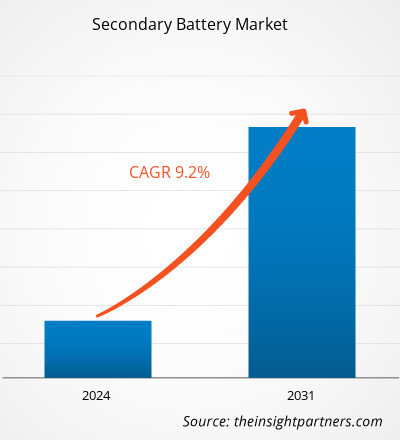The global secondary battery market size is expected to grow from US$ 66.32 billion in 2023 to US$ 134.10 billion by 2031; it is anticipated to expand at a CAGR of 9.2% from 2024 to 2031. The increasing adoption of electric vehicles is likely to remain a key secondary battery market trends.
Secondary Battery Market Analysis
The growth of the global market can be attributed to factors including technological advancements, a surge in end-user industries, and government policy-level support to promote energy storage infrastructure.
Secondary Battery Market Overview
A rechargeable battery, storage battery, or secondary cell (officially known as an energy accumulator) is a type of electrical battery that may be charged, discharged into a load, and recharged several times, as opposed to a disposable or main battery, which is delivered fully charged and discarded after use. It consists of one or more electrochemical cells. The term "accumulator" refers to something that gathers and stores energy via a reversible electrochemical process. Rechargeable batteries come in a variety of forms and capacities, from button cells to megawatt systems used to stabilize an electrical distribution network. Various electrode materials and electrolytes are utilized, including lead-acid, zinc-air, nickel-cadmium (NiCd), nickel-metal hydride (NiMH), lithium-ion (Li-ion), lithium iron phosphate (LiFePO4), and lithium-ion polymer.
Customize This Report To Suit Your Requirement
You will get customization on any report - free of charge - including parts of this report, or country-level analysis, Excel Data pack, as well as avail great offers and discounts for start-ups & universities
Secondary Battery Market: Strategic Insights

- Get Top Key Market Trends of this report.This FREE sample will include data analysis, ranging from market trends to estimates and forecasts.
Customize This Report To Suit Your Requirement
You will get customization on any report - free of charge - including parts of this report, or country-level analysis, Excel Data pack, as well as avail great offers and discounts for start-ups & universities
Secondary Battery Market: Strategic Insights

- Get Top Key Market Trends of this report.This FREE sample will include data analysis, ranging from market trends to estimates and forecasts.
Secondary Battery Market Drivers and Opportunities
Rising Focus on Renewable Power to Favor Market
Renewable power generation is becoming more popular throughout the world, with Germany and France leading the way in the deployment of renewable energy technology. However, these countries continue to rely on net electricity imports. Emerging nations, on the other hand, are adopting renewable energy while becoming net power importers due to rising energy consumption and insufficient grid infrastructure. This circumstance highlights the vital necessity for energy storage technologies, particularly secondary batteries, to provide a steady supply of electricity. As a consequence, the worldwide secondary battery market is projected to expand significantly in the approaching years.
Growing demand for Data Processing
The growing demand for data processing is indeed fuelling the demand for the secondary battery market. This is due to several factors, including technological advancements, increasing demand for portable electronics, and the shift towards renewable energy sources. The demand for secondary batteries is driven by technological advancements and the increasing demand for portable electronics such as smartphones, tablets, and wearable devices. These devices require reliable and efficient power sources, and secondary batteries provide the necessary energy storage.
Secondary Battery Market Report Segmentation Analysis
Key segments that contributed to the derivation of the secondary battery market analysis technology and application.
- Based on technology, the market is bifurcated into lead-acid secondary battery, lithium-ion secondary battery, and other technologies. The lead-acid secondary battery segment held a larger market share in 2023.
- Based on application, the market is bifurcated into automotive, industrial, portable batteries, medical device, forklift, and other applications. The industrial segment held a larger market share in 2023.
Secondary Battery Market Share Analysis by Geography
The geographic scope of the secondary battery market report is mainly divided into five regions: North America, Asia Pacific, Europe, Middle East & Africa, and South America/South & Central America. North America dominated the secondary battery market in 2023. The battery market in the North American region, which includes the United States, Canada, and Mexico, is experiencing significant growth due to factors such as a strong focus on sustainable development and increased awareness of the negative effects of traditional automobiles. The rising levels of global pollution and the diminishing availability of fossil fuels have created a demand for environmentally friendly transportation solutions. In response to these concerns, automotive manufacturers are adopting advanced technologies and incorporating lithium-ion batteries in hybrid and electric vehicles (EVs) to address the pressing need for environmental preservation.
Secondary Battery Market Regional Insights
The regional trends and factors influencing the Secondary Battery Market throughout the forecast period have been thoroughly explained by the analysts at Insight Partners. This section also discusses Secondary Battery Market segments and geography across North America, Europe, Asia Pacific, Middle East and Africa, and South and Central America.

- Get the Regional Specific Data for Secondary Battery Market
Secondary Battery Market Report Scope
| Report Attribute | Details |
|---|---|
| Market size in 2023 | US$ 66.32 Billion |
| Market Size by 2031 | US$ 134.10 Billion |
| Global CAGR (2023 - 2031) | 9.2% |
| Historical Data | 2021-2022 |
| Forecast period | 2024-2031 |
| Segments Covered |
By Technology
|
| Regions and Countries Covered | North America
|
| Market leaders and key company profiles |
Secondary Battery Market Players Density: Understanding Its Impact on Business Dynamics
The Secondary Battery Market market is growing rapidly, driven by increasing end-user demand due to factors such as evolving consumer preferences, technological advancements, and greater awareness of the product's benefits. As demand rises, businesses are expanding their offerings, innovating to meet consumer needs, and capitalizing on emerging trends, which further fuels market growth.
Market players density refers to the distribution of firms or companies operating within a particular market or industry. It indicates how many competitors (market players) are present in a given market space relative to its size or total market value.
Major Companies operating in the Secondary Battery Market are:
- Amperex Technology Limited
- BYD Company Ltd
- Duracell Inc
- EnerSys
- Contemporary Amperex Technology Co. Limited
- Panasonic Corporation
Disclaimer: The companies listed above are not ranked in any particular order.

- Get the Secondary Battery Market top key players overview
Secondary Battery Market News and Recent Developments
The secondary battery market is evaluated by gathering qualitative and quantitative data post primary and secondary research, which includes important corporate publications, association data, and databases. The following is a list of developments in the market:
- In April 2024, BYD, a Chinese car manufacturer, is set to introduce its second-generation 'blade' battery pack in August 2024. This new battery technology is expected to have enough range to drive an electric car from Sydney to Melbourne on a single charge. The second-generation blade battery pack will be based on BYD's proprietary lithium-ion phosphate (LFP) battery technology. It is worth noting that this technology will surpass the introduction of solid-state batteries with a similar claimed range by Toyota, which is currently planned for 2026 at the earliest.
(Source: BYD, Press Release, 2024)
Secondary Battery Market Report Coverage and Deliverables
The "Secondary Battery Market Size and Forecast (2021–2031)" report provides a detailed analysis of the market covering below areas:
- Market size and forecast at global, regional, and country levels for all the key market segments covered under the scope
- Market dynamics such as drivers, restraints, and key opportunities
- Key future trends
- Detailed PEST/Porter's Five Forces and SWOT analysis
- Global and regional market analysis covering key market trends, major players, regulations, and recent market developments
- Industry landscape and competition analysis covering market concentration, heat map analysis, prominent players, and recent developments
- Detailed company profiles
- Historical Analysis (2 Years), Base Year, Forecast (7 Years) with CAGR
- PEST and SWOT Analysis
- Market Size Value / Volume - Global, Regional, Country
- Industry and Competitive Landscape
- Excel Dataset



Report Coverage
Revenue forecast, Company Analysis, Industry landscape, Growth factors, and Trends

Segment Covered
Technology ; Application

Regional Scope
North America, Europe, Asia Pacific, Middle East & Africa, South & Central America

Country Scope
Argentina, Australia, Brazil, Canada, China, France, Germany, India, Italy, Japan, Mexico, Russian Federation, Saudi Arabia, South Africa, South Korea, United Arab Emirates, United Kingdom, United States
Frequently Asked Questions
The secondary battery market size is expected to grow from US$ 66.32 billion in 2023 to US$ 134.10 billion by 2031; it is anticipated to expand at a CAGR of 9.2% from 2024 to 2031.
The growth of the global market can be attributed to several factors that have contributed to its expansion. These factors include technological advancements, a surge in end-user industries, and government policy-level support to promote energy storage infrastructure.
The increasing adoption of electric vehicles is likely to remain a key secondary battery market trends.
The key players holding the majority of shares in the global secondary battery are Panasonic Corporation, SaftGroupe SA, Samsung SDI Co., Ltd., GS Yuasa International Ltd., and LG Chem.
The global secondary battery market is expected to reach US$ 134.10 billion by 2031.

 Get Free Sample For
Get Free Sample For